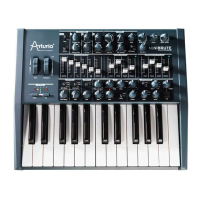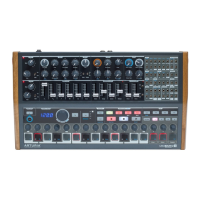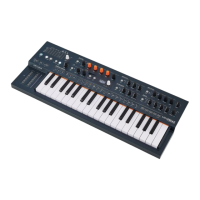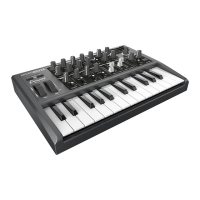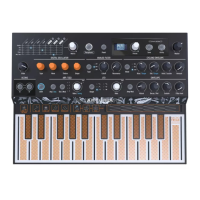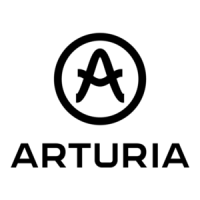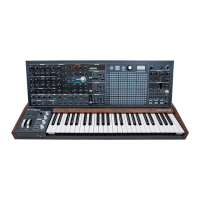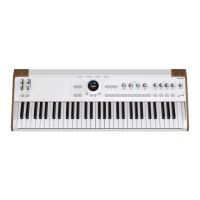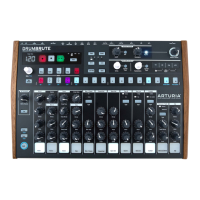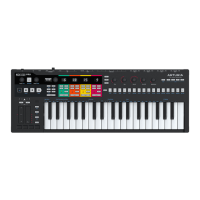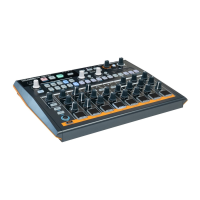Do you have a question about the Arturia minibrute 2 series and is the answer not in the manual?
Guidelines for safe operation and handling of the product.
Critical warnings regarding placement and extension cords for safe use.
Process to register the instrument for ownership and updates.
Overview of connection procedures and available connectors.
Details of connectors on the rear panel of the MiniBrute 2.
Illustrates the patch bay connections with modular synths and external audio sources.
Instructions for initial warm-up and pitch tuning of the analog synthesizer.
Step-by-step guide to setting up a basic sound patch on the synthesizer.
Learn to add vibrato and use a second oscillator for richer sound.
Explains the function of AD and ADSR envelopes for sound shaping.
Explains the ADSR envelope stages (Attack, Decay, Sustain, Release) for filter modulation.
Demonstrates using an LFO to modulate filter cutoff for timbre sweeps.
Introduction to the built-in sequencer and arpeggiator functions.
How to switch modes, and record sequences.
Overview of the MiniBrute 2's main features, including the keyboard.
Details of the control section, including keyboard and wheels.
Explains keyboard features, pitch/mod wheels, octave transposition, and Shift button.
Determines modulation source and routing; overview of inputs/outputs and top panel.
Description of rear panel connectors, including Kensington lock, outputs, MIDI, USB, and power.
Explanation of the two LFOs and their waveform options.
Details of VCO 1 and VCO 2 controls for sound generation.
Explanation of filter modes, cutoff, resonance, and modulation.
Controls for Brute Factor, Master Volume, Global Tune, and Amp modulation.
Controls levels for Saw, Square, Triangle, Metalizer, Noise, and External inputs.
ADSR and AD envelope controls for filter and amplifier shaping.
Decides how notes respond in legato, retriggering envelopes or not.
Explanation of subtractive synthesis and the signal chain in analog synths.
Describes signal generators, noise, and wave-shaping techniques.
Defines filters and their role in modifying spectral content of signals.
Detailed explanation of filter types and how resonance affects sound.
The amplifier stage and modulators like LFOs and envelopes.
Basic concepts and layout of the patch bay.
Distinguishes between input and output jacks and their usage.
Explains blue labels indicating default input routings and how patch cables override them.
How patch bay jacks connect to external devices for synchronization.
Details of inputs and outputs for VCO 1 in the patch bay.
Details of inputs and outputs for VCO 2 in the patch bay.
Routing external audio through the MiniBrute 2's signal path.
Filter patch bay inputs for FM, RM, and Cutoff modulation.
AMP section for amplitude control and Inverter for signal inversion.
ADSR and AD envelope patch points for trigger and output signals.
LFO outputs and VCA section for routing and control voltage.
Attenuators tame output signals, used to control modulation amounts.
Sequencer patch points and MIDI section outputs.
Selecting between Sequencer (Seq) and Arpeggiator (Arp) modes.
Controls for tempo, time division, and tap/rest.
Toggling the metronome and using transport buttons for playback.
Controls for note gate time and swing for rhythmic feel.
Explains the interaction between Master Swing and Time Division settings.
Allows skipping modes/divisions and restarting sequences/arpeggios.
Configuring MiniBrute 2 as master or slave clock source.
Fundamental operations for selecting and playing sequences.
Adjusting playback tempo and changing rhythmic relationships.
Modes for transposing sequences or playing live notes simultaneously.
Creating sequences by recording notes step-by-step or in real-time.
How to insert rests and make notes hold over into subsequent steps.
Recording or replacing notes in a sequence while it is looping.
Details on what data is recorded per step and per sequence.
Ways to extend, alter existing sequences and store them.
Definition and concept of an arpeggiator.
Overview of arpeggiator features covered in shared and this chapter.
Fundamental operations for using the arpeggiator.
Controls for tempo, time division, and keeping arpeggios playing.
Detailed explanation of the different arpeggiator modes.
Adding up to 16 notes to an arpeggio using Hold and Octave functions.
How to pause and resume an arpeggio pattern mid-play.
Basic information about MCC and how to access its help file.
Lists system requirements and instructions for installing MCC.
Connecting the MiniBrute 2 to a computer via USB and troubleshooting.
How to find the MIDI Control Center manual within the software.
Overview of the Template Browser for managing sequences.
Managing device memories, focusing on the Working Memory.
Lists available Templates and how to drag/drop them.
Transmitting and retrieving templates to/from the MiniBrute 2.
Managing files and importing/exporting device settings.
Methods for entering parameter values in MCC.
Accessing and configuring various MIDI controller settings within MCC.
Configuration for sequence playback and sync clock settings.
Settings for transposing sequences via MIDI input.
Selecting CV/Gate behavior and configuring transport controls.
Selects Gate settings for Sequencer and Arpeggiator.
Selects Swing settings for Sequencer and Arpeggiator.
Switches between Retrig and Legato note retriggering modes.
Toggles Sequence Transpose and Keyboard Play modes.
Restarts sequences, appends data, and clears the last step.
Skips sequences/modes, toggles metronome, and activates Arp Hold mode.
Selects non-adjacent Time Division settings without passing through intermediate ones.
Guidelines for safe operation and handling of the product.
Critical warnings regarding placement and extension cords for safe use.
Process to register the instrument for ownership and updates.
Overview of connection procedures and available connectors.
Details of connectors on the rear panel of the MiniBrute 2.
Illustrates the patch bay connections with modular synths and external audio sources.
Instructions for initial warm-up and pitch tuning of the analog synthesizer.
Step-by-step guide to setting up a basic sound patch on the synthesizer.
Learn to add vibrato and use a second oscillator for richer sound.
Explains the function of AD and ADSR envelopes for sound shaping.
Explains the ADSR envelope stages (Attack, Decay, Sustain, Release) for filter modulation.
Demonstrates using an LFO to modulate filter cutoff for timbre sweeps.
Introduction to the built-in sequencer and arpeggiator functions.
How to switch modes, and record sequences.
Overview of the MiniBrute 2's main features, including the keyboard.
Details of the control section, including keyboard and wheels.
Explains keyboard features, pitch/mod wheels, octave transposition, and Shift button.
Determines modulation source and routing; overview of inputs/outputs and top panel.
Description of rear panel connectors, including Kensington lock, outputs, MIDI, USB, and power.
Explanation of the two LFOs and their waveform options.
Details of VCO 1 and VCO 2 controls for sound generation.
Explanation of filter modes, cutoff, resonance, and modulation.
Controls for Brute Factor, Master Volume, Global Tune, and Amp modulation.
Controls levels for Saw, Square, Triangle, Metalizer, Noise, and External inputs.
ADSR and AD envelope controls for filter and amplifier shaping.
Decides how notes respond in legato, retriggering envelopes or not.
Explanation of subtractive synthesis and the signal chain in analog synths.
Describes signal generators, noise, and wave-shaping techniques.
Defines filters and their role in modifying spectral content of signals.
Detailed explanation of filter types and how resonance affects sound.
The amplifier stage and modulators like LFOs and envelopes.
Basic concepts and layout of the patch bay.
Distinguishes between input and output jacks and their usage.
Explains blue labels indicating default input routings and how patch cables override them.
How patch bay jacks connect to external devices for synchronization.
Details of inputs and outputs for VCO 1 in the patch bay.
Details of inputs and outputs for VCO 2 in the patch bay.
Routing external audio through the MiniBrute 2's signal path.
Filter patch bay inputs for FM, RM, and Cutoff modulation.
AMP section for amplitude control and Inverter for signal inversion.
ADSR and AD envelope patch points for trigger and output signals.
LFO outputs and VCA section for routing and control voltage.
Attenuators tame output signals, used to control modulation amounts.
Sequencer patch points and MIDI section outputs.
Selecting between Sequencer (Seq) and Arpeggiator (Arp) modes.
Controls for tempo, time division, and tap/rest.
Toggling the metronome and using transport buttons for playback.
Controls for note gate time and swing for rhythmic feel.
Explains the interaction between Master Swing and Time Division settings.
Allows skipping modes/divisions and restarting sequences/arpeggios.
Configuring MiniBrute 2 as master or slave clock source.
Fundamental operations for selecting and playing sequences.
Adjusting playback tempo and changing rhythmic relationships.
Modes for transposing sequences or playing live notes simultaneously.
Creating sequences by recording notes step-by-step or in real-time.
How to insert rests and make notes hold over into subsequent steps.
Recording or replacing notes in a sequence while it is looping.
Details on what data is recorded per step and per sequence.
Ways to extend, alter existing sequences and store them.
Definition and concept of an arpeggiator.
Overview of arpeggiator features covered in shared and this chapter.
Fundamental operations for using the arpeggiator.
Controls for tempo, time division, and keeping arpeggios playing.
Detailed explanation of the different arpeggiator modes.
Adding up to 16 notes to an arpeggio using Hold and Octave functions.
How to pause and resume an arpeggio pattern mid-play.
Basic information about MCC and how to access its help file.
Lists system requirements and instructions for installing MCC.
Connecting the MiniBrute 2 to a computer via USB and troubleshooting.
How to find the MIDI Control Center manual within the software.
Overview of the Template Browser for managing sequences.
Managing device memories, focusing on the Working Memory.
Lists available Templates and how to drag/drop them.
Transmitting and retrieving templates to/from the MiniBrute 2.
Managing files and importing/exporting device settings.
Methods for entering parameter values in MCC.
Accessing and configuring various MIDI controller settings within MCC.
Configuration for sequence playback and sync clock settings.
Settings for transposing sequences via MIDI input.
Selecting CV/Gate behavior and configuring transport controls.
Selects Gate settings for Sequencer and Arpeggiator.
Selects Swing settings for Sequencer and Arpeggiator.
Switches between Retrig and Legato note retriggering modes.
Toggles Sequence Transpose and Keyboard Play modes.
Restarts sequences, appends data, and clears the last step.
Skips sequences/modes, toggles metronome, and activates Arp Hold mode.
Selects non-adjacent Time Division settings without passing through intermediate ones.
| Type | Analog Synthesizer |
|---|---|
| Arpeggiator | Yes |
| Polyphony | Monophonic |
| Filter | Steiner-Parker multimode filter |
| LFO | 1 LFO with multiple waveforms |
| Envelopes | 2 ADSR Envelopes |
| Keyboard | 25-note keyboard with velocity |
| Sequencer | 64-step sequencer |
| Connectivity | MIDI In/Out, USB |
| Waveforms | Sawtooth, Square, Triangle, Sine |
| Audio Input | 1 x 1/4" |
| Audio Output | 1 x 1/4" output |
| Power Supply | External power supply (included) |
